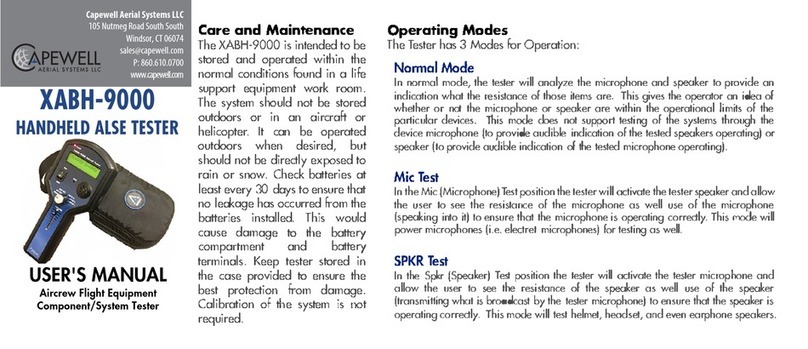
PRODUCT DESCRIPTION AND
OPERATION
The unit simulates an intercom system for verifying proper
operation by wearing the headset and speaking into the
communications microphone. Includes a built-in microphone
and a speaker for testing individual speakers and microphones
and for trouble-shooting in the event normal loop-back testing
fails. The internal microphone has automatic gain control so
that it can be used up close or sitting on a table picking up
ambient noise.A six-position rotary switch selects the operating
mode...
Normal - headset microphone is connected to the headset
speakers.
Mic test- headset microphone is connected to the headset
speakers and the internal speaker.
Spkr test - internal microphone is connected to the headset
speakers.
Preset A, B, C - same as normal mode but compares readings
to stored values to display error messages should the readings
deviate significantly. Presets are programmed by connecting a
known-good headset and depressing the recessed programming
switch on the top of the tester.
The volume control sets the output level of both the headset
speakers and the internal speaker.
A 13-pin connector permits interfacing with various types of
headset connectors and individual speaker and microphone
elements. Custom adapters can be provided for specific
applications. The connector includes power lines and access to
the processor for field code updates if needed, and to permit
the construction of specialized adapters that take over the
display.
The unit is powered by 3 AA cells, typical battery lifetime is
about 30 hours of actual usage and about 90 hours turned on
but not being used. Current drain is about 65ma to 90ma
while operating with the LCD back-light on and connected to a
microphone. After a few minutes the LCD back-light is turned
off to conserve power, idle current without a headset connected
is about 25ma. The back-light is restored when a headset is
connected or the mode switch is operated. Remove the
batteries when the unit is stored for more than a month.
Recommended battery type is Duracell MN1500.
The unit automatically detects the microphone type
and engages the appropriate pre-amplifier and bias. Dynamic
microphones are measured by applying a current of about
0.5ma (5V source with 10K series resistance), microphones
with a resistance of less than 25 ohms are considered
low-impedance and engage a higher gain preamp. Polarized
condenser microphones are measured by biasing from a 5V
source with 5K series resistance (1ma max). Amplified
microphones are measured by biasing from a 10V source with
560 ohms series resistance. Speakers are measured by
applying a current of about 0.45ma (0.45V source with 1K
series resistance). Output impedance is roughly 15 ohms to
minimize the volume differences between low and medium
impedance headsets.
OPERATION
When a microphone is connected, the unit detects the mic type
and selects an appropriate
Type L = dynamic microphone under about 25
ohms, 54db-gain preamp, 150 ohm input-Z
Type H = dynamic microphone over about 25
ohms, 46db-gain preamp, 150 ohm input-Z
Type P = polarized electret condenser microphone,
5V/5K bias, 12db-gain preamp
Type E = amplified electret microphone assembly,
10V/560 ohm bias, 3db-gain preamp
LCD display shows mic/speaker data and mic signal output
On power-up the unit briefly displays the battery
voltage. “LB” appears in the lower right corner if the battery
voltage is below about 3.6V, and the back-light is disabled if
the battery voltage is under about 3.1V. In normal operation
the back-light is turned off after a few minutes of non-use.
TECHNICAL NOTES
The tester uses three commonly-available alkaline AA-type
batteries, such as the Duracell type MN1500 or MX1500, or
the Energizer E91. Carefully inspect the batteries before
installing, do not use if the case shows any sign of damage or
if there is any corrosion on the terminals. Periodically inspect
the battery holder terminals for corrosion, if any corrosion or
discoloration is noted, then clean the terminals using alcohol
and a swap. Batteries must be installed correctly with the
springs contacting the flat minus terminal. Remove the
batteries when the tester is not being used for a period of more
than one month.
Rechargeable NiMh or NiCd batteries may be used, however the
LB (low battery) indicator will be shown early, and the unit must
be turned off when the back-light remains off to avoid damage
to the batteries. Leaving the unit on past the point where the
back-light no longer comes on will damage rechargeable
batteries due to polarity reversal effects.
The display shows OPEN if microphone and/or speaker is not
connected. If the microphone type cannot be determined then
displays UNKN (unknown). The speaker and microphone
readings are updated roughly twice a second. Speaker and
dynamic microphone resistance is shown in ohms.
Electric microphones are given a rating number based on current
drain:
Unit displays ma*100 for type P microphones (i.e. Mi=P50
means 0.5ma),
Unit displays ma*10 for type E microphones (i.e. Mi=E115
means 11.5ma).
Measurement accuracy is about +/-3% after stabilizing and with
no audio signal.
The 2nd line shows the relative output of the microphone
preamp, with the peak held for roughly a second to make it
easier to visualize the microphone output level in response to
speech.
Function Switch
Position 1 - normal manual operation
Position 2 - microphone test mode (turns on internal speaker)
Position 3 - speaker test mode (turns on internal microphone)
In all modes, the signal from the headset mic is
delivered to the headset speaker. In microphone test mode, the
signal from the headset mic is also delivered to an internal
speaker. In speaker test mode, a signal from an internal
microphone is delivered to the headset speaker and the signal
from the headset microphone is attenuated by about 10db. The
internal microphone has automatic gain control to adapt to the
peak sound level.
In preset modes, program the unit by connecting a good
headset and pressing the pushbutton switch located behind an
access hole on the top of the unit.





















